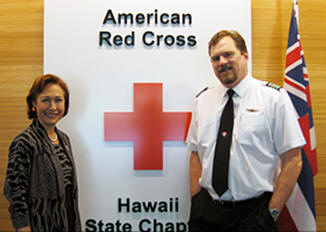|
|||||||||||||||||
|
|
|
|||
|
Hawaiian Airlines Pilots Raise Money For Victims
Of Japan’s Tsunami By Mike Mitchell |
||||
 |
April 17, 2011 - Hawaiian Airlines members of the Air
Line Pilots Association, Int’l. (ALPA) have donated
$14,500 to assist victims of earthquake and tsunami
disasters in
Individual pilots donated $9,500, with ALPA’s Hawaiian
Airlines Master Executive Council (MEC) donating an
additional $5,000. HAL Capt. Rick Baldwin of
“Most of us at Hawaiian Airlines have some sort of link
to
“We all wanted to do something to help out, not only
financially but to let the people who are suffering in |
|||
|
Pictured: Coralie Matayoshi, CEO of the Hawaii state
chapter of the American Red Cross, and HAL Capt. Rick
Baldwin. |
||||
|
The
donation is the latest charitable outreach by the pilot group’s
newly-organized Community Affairs Committee, created last year
to perform community service and humanitarian work in the
Islands and elsewhere in
“As
residents of the unstable ‘Ring of Fire’ in the Pacific, we know
earthquakes, tsunamis and typhoons are a constant threat,”
The 2011
Tōhoku earthquake and tsunami, literally "Eastern Japan Great
Earthquake Disaster", officially named the Great East Japan
Earthquake, was caused by a 9.0-magnitude undersea megathrust
earthquake off the coast of |
||||

